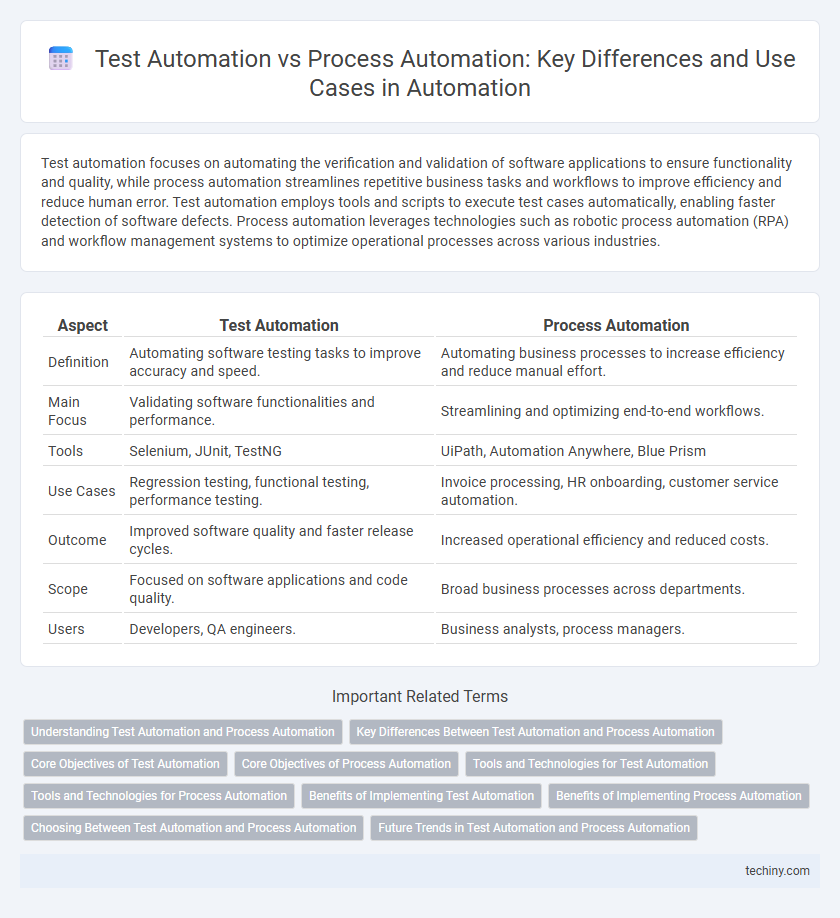Test automation focuses on automating the verification and validation of software applications to ensure functionality and quality, while process automation streamlines repetitive business tasks and workflows to improve efficiency and reduce human error. Test automation employs tools and scripts to execute test cases automatically, enabling faster detection of software defects. Process automation leverages technologies such as robotic process automation (RPA) and workflow management systems to optimize operational processes across various industries.
Table of Comparison
| Aspect | Test Automation | Process Automation |
|---|---|---|
| Definition | Automating software testing tasks to improve accuracy and speed. | Automating business processes to increase efficiency and reduce manual effort. |
| Main Focus | Validating software functionalities and performance. | Streamlining and optimizing end-to-end workflows. |
| Tools | Selenium, JUnit, TestNG | UiPath, Automation Anywhere, Blue Prism |
| Use Cases | Regression testing, functional testing, performance testing. | Invoice processing, HR onboarding, customer service automation. |
| Outcome | Improved software quality and faster release cycles. | Increased operational efficiency and reduced costs. |
| Scope | Focused on software applications and code quality. | Broad business processes across departments. |
| Users | Developers, QA engineers. | Business analysts, process managers. |
Understanding Test Automation and Process Automation
Test Automation involves using software tools to execute predefined test cases, validate software functionality, and ensure code quality through repeatable and efficient testing processes. Process Automation focuses on streamlining and automating end-to-end business workflows by integrating multiple tasks, systems, and human interactions to improve operational efficiency and reduce manual intervention. Understanding the distinction helps organizations strategically implement automation to enhance software development cycles and optimize business operations.
Key Differences Between Test Automation and Process Automation
Test automation focuses on validating software functionality through automated test scripts to ensure product quality, while process automation streamlines and automates business workflows to increase operational efficiency. Key differences include their primary objectives--test automation aims to detect defects in software, whereas process automation targets repetitive task execution across various business functions. Tools like Selenium and JUnit are commonly used in test automation, whereas process automation often involves platforms like UiPath, Automation Anywhere, or Blue Prism.
Core Objectives of Test Automation
Test automation primarily aims to enhance software quality by executing repetitive test cases quickly and accurately, reducing human error and increasing coverage. It focuses on validating functionality, performance, and security through automated test scripts that ensure consistent software behavior across different environments. This approach accelerates the software development lifecycle by enabling continuous integration and rapid feedback for early defect detection.
Core Objectives of Process Automation
Process automation primarily aims to streamline and optimize complex business workflows by reducing manual intervention, improving accuracy, and enhancing operational efficiency. It focuses on automating end-to-end processes across multiple systems to ensure consistent output and faster cycle times. Key objectives include minimizing human errors, increasing productivity, and enabling real-time monitoring and scalability of business operations.
Tools and Technologies for Test Automation
Test Automation relies on specialized tools like Selenium, JUnit, and Appium to execute repetitive test cases efficiently, ensuring software quality through automated scripts. These tools support various programming languages and integrate with CI/CD pipelines, facilitating continuous testing and faster bug detection. Advanced frameworks leverage AI and machine learning to enhance test coverage, optimize test case generation, and predict potential failure points, driving smarter automation strategies.
Tools and Technologies for Process Automation
Process automation leverages advanced tools such as Robotic Process Automation (RPA) platforms, Business Process Management (BPM) software, and Intelligent Automation powered by Artificial Intelligence (AI) and Machine Learning (ML) to streamline complex workflows and repetitive tasks. Key technologies include UiPath, Automation Anywhere, Blue Prism for RPA, and platforms like Appian and Pega for BPM, enabling seamless integration across enterprise systems. These tools prioritize scalability, real-time monitoring, and low-code/no-code capabilities to optimize end-to-end business processes beyond the scope of test automation.
Benefits of Implementing Test Automation
Implementing test automation significantly enhances software quality by enabling rapid and consistent execution of repetitive test cases, reducing human error and increasing test coverage. It accelerates development cycles through continuous integration and continuous delivery (CI/CD) pipelines, ensuring faster detection of defects and reducing time-to-market. Automated testing also lowers long-term costs by minimizing manual labor, improving ROI, and supporting scalable, reliable software releases.
Benefits of Implementing Process Automation
Process automation enhances operational efficiency by streamlining complex workflows and reducing human errors in repetitive tasks. It enables scalability and consistency across business processes, leading to improved productivity and cost savings. Implementing process automation supports real-time data tracking and better compliance management, optimizing overall organizational performance.
Choosing Between Test Automation and Process Automation
Choosing between test automation and process automation requires evaluating the specific business needs and goals. Test automation focuses on improving software quality and reducing testing time by automating test cases, while process automation streamlines repetitive business workflows to increase operational efficiency and reduce human error. Organizations must consider factors such as desired outcomes, scalability, and existing infrastructure to determine the most effective automation strategy.
Future Trends in Test Automation and Process Automation
Future trends in test automation emphasize AI-driven test case generation, predictive analytics for defect detection, and continuous integration with DevOps pipelines to enhance software quality and release velocity. Process automation is advancing with intelligent automation technologies such as robotic process automation (RPA) integrated with machine learning models to optimize business workflows and improve operational efficiency. Both test automation and process automation are converging through hyperautomation frameworks, enabling end-to-end automation that reduces manual intervention and accelerates digital transformation initiatives.
Test Automation vs Process Automation Infographic

 techiny.com
techiny.com